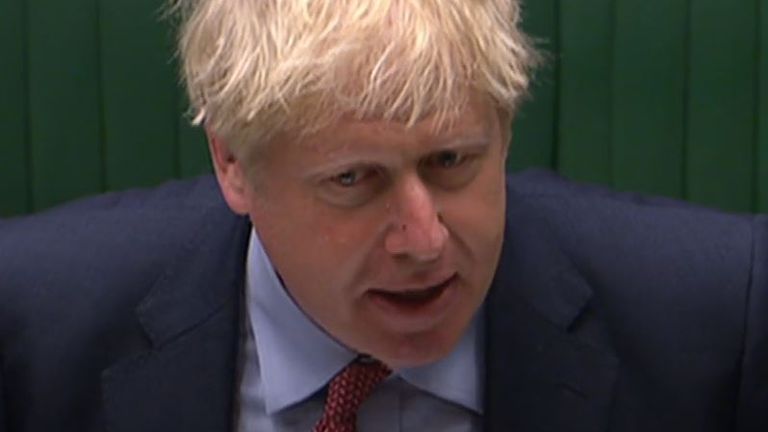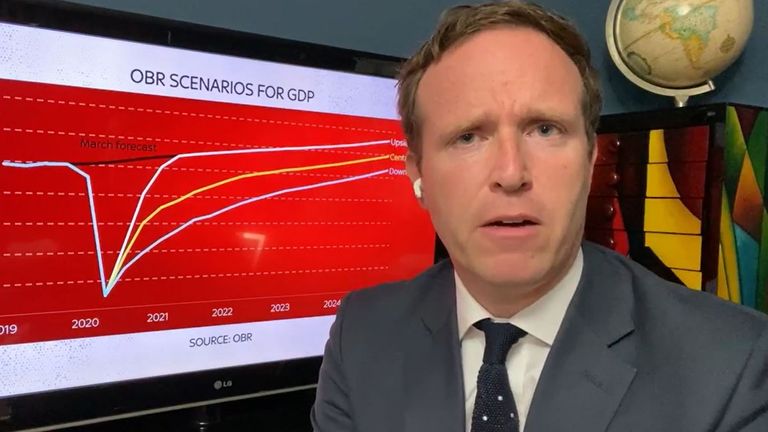Official data suggests almost 650,000 UK workers have lost their jobs during the coronavirus pandemic amid fears an employment crisis exceeding that of the 1980s is looming.
The Office for National Statistics (ONS) revealed data showing that 649,000 people left company payrolls between March and June – covering the economy’s enforced hibernation to limit the spread of COVID-19.
The figures, taken from HM Revenue and Customs, showed 74,000 fewer people on the PAYE register during June compared to the previous month.
They were released in a week where the Office for Budget Responsibility warned the UK could be facing a jobless rate of around 13% – exceeding three million – from its current rate of 3.9% as unemployment begins to accelerate despite continuing government support for businesses and their wage bills.
The latest Treasury figures showed 9.4 million furloughed workers were still getting salary support from the Job Retention Scheme. It is due to end in October.
A further 2.7 million self-employed are also getting help.
A survey for UK business group the BCC, released on Thursday, supported forecasts of a surge in joblessness by suggesting almost a third of UK firms plan to lay off staff over the next three months.
The ONS data showed the pace of job losses slowed in June, with claims under Universal Credit by the unemployed and those on low incomes falling by 28,100 between May and June to 2.6 million.
But in its commentary, the ONS acknowledged the pace of job losses had since started to pick up.
Deputy national statistician Jonathan Athow said: “As the pandemic took hold, the labour market weakened markedly, but that rate of decline slowed into June, though this is before recent reports of job losses.
“There are now almost two-thirds of a million fewer employees on the payroll than before the lockdown, according to the latest tax data.
“The Labour Force Survey is showing only a small fall in employment, but shows a large number of people who report working no hours and getting no pay.”
He added: “There are now far more out-of-work people who are not looking for a job than before the pandemic.”
As economists had predicted, the wider statistics showed a negative picture for pay growth, with average weekly earnings down by 0.3% on an annual basis during the three months to May.
It marked the first such fall since 2014 while the biggest dive in employment since 2011, over the same period, was mostly driven by the self-employed.
Chief economist at KPMG UK, Yael Selfin, responded to the data covering June by saying it represented the “calm before the storm”.
He added: “Today’s figures point at the success of the government’s furlough scheme to shield the labour market from the worse of the immediate crisis.
“But as the Job Retention Scheme unwinds in coming months, the full impact of the recession on unemployment is likely to be revealed.”
The minister for employment, Mims Davies, said: “We know that people are worried about their livelihoods which is why we’ve put in place a Plan for Jobs.
“A crucial part of that is doubling the number of frontline Work Coaches so that every jobseeker gets support to find work as well as launching the Kickstart scheme to create hundreds of thousands of new, fully subsidised jobs for young people across the country.”
Labour said the ONS figures underlined the need for continuing financial support for the sectors worst affected by the lockdown.
Analysis: The statistics are failing to show us the real picture
By Ed Conway, economics editor
There is a definite sense of unreality about today’s unemployment data.
We all know we are in the midst of a major jobs crisis, so why do the headline figures we tend to focus on not show a rise in unemployment – indeed why is the official unemployment rate is still below 4%?
The answer comes in two parts. The first is that these jobs figures always take some time to reflect what’s going on in the labour market.
That’s the case in all countries but the UK’s jobs figures are especially “laggy”, as economists would call it. So the headline number of 3.9% unemployment depicts the period between March and May, which pre-dates many of the redundancies and job cuts we’ve heard about since.
The second answer is that in that period rather than losing their jobs, millions of Britons were on the furlough scheme which meant they technically remained employed, even though they were not working.
The upshot of all of this is that we must rely on alternative sources of data for the real picture of what’s going on: the ONS’s measures of hours worked, payroll jobs and earnings all show very sharp falls in recent months, even if the headline unemployment rate doesn’t.
And here at Sky News we are producing our own measures of job losses which reflect many of those announcements of redundancies and cuts from recent weeks.
There is little doubt the UK is facing a jobs recession – the worst, most probably, since the 1980s. The sad reality is that that is likely to become clear from the statistics in the coming year, even if it is not at present.





